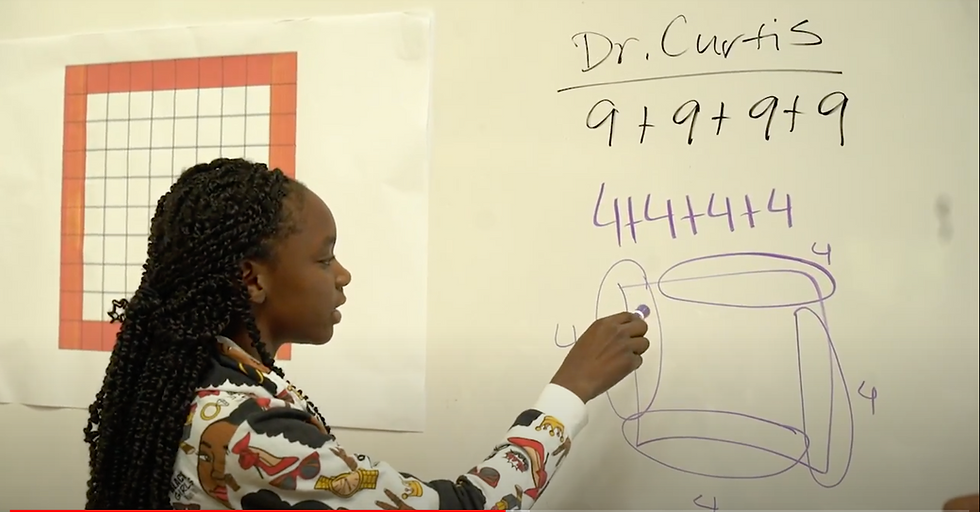Reflecting on the Research Lesson & Sharing Findings
- Yay Math!
- Jun 24, 2020
- 4 min read
This blog series documents how our network of schools became interested in lesson study. We have shared how our lesson study teams got started – by creating a shared vision of their hopes and dreams for students, determining a research question and theory of action, narrowing in on a specific content area for their research lesson, and then exploring the mathematical content and selecting a mathematical understanding goal and an equity goal for their research lessons. We have also documented our first four public lesson study events, a 6th grade lesson on setting up algebraic expressions, 3rd grade lesson on comparing fractions, a 9th grade lesson on lines of best fit, an 8th grade lesson on negative exponents, and a 10th grade lesson on quadratics.

A student shares her thinking during a 6th grade lesson on creating algebraic expressions from numerical expressions.
In the last post we highlighted the importance of closely observing student thinking in order to learn how students develop a deep understanding of key mathematical concepts. In this final post of our research lesson study series we’ll explore how lesson study research teams use these data to reflect on their research question and theory of action and share their learning more broadly.
Once a team has completed a research lesson the host teacher has the opportunity to reflect first. This can be done publicly or during a private team debrief. For our larger public research lessons the host teacher reflects publicly for a few minutes followed by each team member, followed by commentary from the content and equity experts. The team then holds a longer 60-90 minute private reflection session to go over student data and consolidate their learning. In smaller research lessons without an audience, the team may move right into the debrief and reflection session – using the time to look at student data, hear from the content and equity commentators, and synthesize their learning.
During the debrief and reflection session teams share student observation data from the research lesson, look at focus student work samples, and then discuss the following prompts:
What did we learn about the mathematical concept explored in this lesson? Any new “a ha’s” for our own understanding of the concept?
What did we learn about students thinking about this concept?
What did we learn about teaching and pedagogy?
What did we learn about our research question?
What did we learn about our theory of action?
What do individual team members want to implement in their own practice?
What should happen for this class tomorrow?
To launch the debrief conversation, our research teams have found it important to start by presenting student data without making any inferences or adding interpretations of what the data might suggest. The team shares concrete data: What was observed? What did students say and do? How did they approach the task? Starting with objective data before discussing the debrief prompts keeps personal biases at bay and allows space for different interpretations of the data to be surfaced. Student strengths that may have been overlooked during the lesson, or not noticed by the observing teacher, may be noticed by others when the data is presented.
As the team engages in a discussion around the prompts, they fill out the final section on their memorialization document to capture their learning. The memorialization document includes an overview of their research lesson and can be shared with colleagues or more broadly. Examples from our public lessons can be found here and here.
Sharing Research Lesson Findings
Learning from research lessons are shared beyond the research team in three significant ways.
Research team members sharing their learning with colleagues through professional development, workshops, sharing their memorialization document, or in other ways
Sharing learning publicly on a blog or other virtual space (such as the memorialization posts on this blog)
Through audience members who attend a public lesson study event
In our network we have found that the most powerful way to share learning from research lessons is through making the lesson public. Over the past two years, we have had over 300 teachers, administrators, researchers and parents attend our public lesson study events. This has served to open conversations about equitable teaching practices and helped create a communal vision of teaching and learning between schools and the communities they serve.
For educators interested in lesson study we have found that:
Reflecting on student observation data and student work samples is a key part of the lesson study process and provides an opportunity for the research team to integrate their new understanding of teaching and learning into their practice
Hosting public research lessons provides a powerful way for schools to connect to the communities they serve. Watching instruction and student learning unfold during a research lesson creates a shared experience for teachers, administrators and parents to use as a starting point to create a shared vision of teaching and learning.
Previous: Closely Observing Student Thinking
Daisy Sharrock works at the Center for Research on Equity and Innovation at the High Tech High Graduate School of Education, and is part of a Student-Centered Learning Research Collaborative-sponsored research team that is currently engaged in the following study: Leveraging the Power of Improvement Networks to Spread Lesson Study. Read more about their current study here. We are grateful to JFF, KnowledgeWorks, and the Student-Centered Learning Research Collaborative and its funders for their support. Learn more at sclresearchcollab.org




Comments